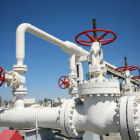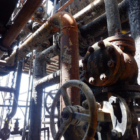Corrosion under insulation (CUI) and corrosion under fireproofing (CUF) pose significant threats to the integrity of industrial infrastructure in petrochemical plants. These insidious forms of corrosion can compromise an asset’s structural integrity, leading to costly leaks, unplanned downtime, and potentially catastrophic failures. Addressing CUI and CUF challenges requires a proactive approach and the deployment of cutting-edge non-destructive testing (NDT) techniques for early detection and prompt intervention.
The Challenge: During a routine assessment of an industrial tower’s skirt area, disturbing evidence of corrosion behind the fireproofing was uncovered. Ultrasonic thickness testing (UTT) revealed localized wall thickness reductions of up to 0.138 inches, exceeding the critical 70% threshold. This finding immediately triggered a comprehensive structural evaluation and the development of a strategic repair plan.
Leveraging Advanced Technologies and Software Tools
The Advanced NDE team employed cutting-edge technologies and industry-leading software to ensure accurate assessments and tailored solutions. COMPRESS software was utilized to compute maximum load capacities and minimum required thicknesses based on design parameters such as temperature, pressure, and operational weight. This analysis established the baseline structural criteria for the repair.
Additionally, the team modeled the corroded and buckled skirt sections using ANSYS Finite Element Analysis (FEA) software. The comprehensive simulation identified stress concentrations and their distributions, enabling a precise assessment of the impacted areas. This thorough investigation provided invaluable insights for developing a practical repair solution.

Customized Repair Strategy and Structural Integrity
Validation The Advanced NDE Division’s repair strategy involved creating a welded patch to address the identified flaws, adhering to the stringent criteria outlined in ASME Section VIII Division 1. The expert team meticulously realigned the buckled section using fixtures and a 50-ton hydraulic jack, progressively applying force and heat between 800 and 1000°F to restore the skirt’s original curvature.
Post-repair, additional ANSYS FEA modeling was conducted to validate the integrity of the repair, ensuring maximum stress levels remained within permissible bounds for long-term viability. Moreover, the comprehensive inspection unearthed cracked anchor bolts, prompting immediate corrective actions to reinforce the tower’s base, maintaining structural integrity through the installation of additional bolts.
This case study highlights the Advanced NDE team’s commitment to employing advanced NDT methods, cutting-edge software, and in-depth technical knowledge to provide customized solutions that protect vital assets and ensure operational excellence. Their proactive approach, leveraging state-of-the-art technologies and industry-leading expertise, enables early detection and effective mitigation of corrosion risks, extending the life and functionality of industrial infrastructure.






